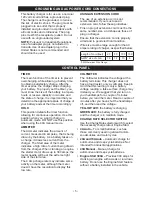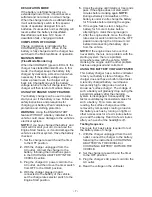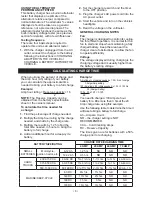
•
6
•
OPERATING INSTRUCTIONS
WARNING:
A spark near battery may cause
battery explosion.
CHARGING A BATTERY IN THE VEHICLE
1.
Turn off all the vehicle’s accessories.
2.
Keep the hood open.
3.
Clean the battery terminals.
4.
Set the charge rate switch and the timer
to the OFF position.
5.
Lay the AC/DC cables away from any fan
blades, belts, pulleys and other moving
parts that can cause injury.
6.
For a negative-ground vehicle (as in
most vehicles), connect the charger’s
POSITIVE (RED) clamp to the POSITIVE
(POS, P, +) battery post. Next, connect
the charger’s NEGATIVE (BLACK) clamp
to the vehicle chassis or engine block,
away from the battery.
7.
For a positive-ground vehicle, connect
the charger’s NEGATIVE (BLACK)
clamp to the NEGATIVE (NEG, N, -)
battery post. Next, connect the charger’s
POSITIVE (RED) clamp to the vehicle
chassis or engine block away from the
battery. NEVER connect any clamps to
the carburetor, fuel lines or sheet-metal
body parts.
8.
Connect the charger to an electrical outlet.
9.
Select the desired automatic charge rate.
NOTE:
The 40 Amp manual mode will
overcharge a battery if it is not monitored.
10.
For 4A, 20A and 70A rates, turn the timer
to HOLD or set the charge time, if using
the 40 Amp manual mode.
11.
When disconnecting the charger, set the
charge rate switch and the timer to the
OFF position, disconnect the charger
from the AC power, remove the clip from
the vehicle chassis, and then remove the
clip from the battery terminal.
CHARGING A BATTERY
OUTSIDE OF THE VEHICLE
1.
First, place battery in a well-ventilated area.
2.
Set the charge rate switch and the timer
to the OFF position.
3.
Clean the battery terminals.
4.
Connect a 24-inch long, 6-gauge (AWG)
insulated battery cable to the NEGATIVE
(NEG, N, -) battery post (i.e., jumper
cable) (not provided).
5.
Connect the POSITIVE (RED) charger
clamp to the POSITIVE (POS, P, +)
battery post.
6.
Position yourself and the “negative post
extension” cable as far away from the
battery as possible, and connect the
NEGATIVE (BLACK) charger clamp to
the cable’s free end.
7.
Connect the charger to the electrical outlet.
8.
Select the desired automatic charge rate.
NOTE:
The 40 Amp manual mode will
overcharge a battery if it is not monitored.
9.
(For 4A, 20A and 70A), turn the timer to
HOLD or set charge time if using the 40
Amp manual mode.
10.
When disconnecting the charger, set the
charge rate switch and the timer to the
OFF position, disconnect the charger from
the AC power, disconnect the negative
clamp, and finally the positive clamp.
11.
A marine (boat) battery must be removed
and charged on shore.
NOTE:
This charger is equipped with a safe
start feature. In the Automatic 4, 20 and 70
Amp charge rates, it will not supply current
to the battery clips until a battery is properly
connected; clips will not spark if touched
together. In the Manual 40 Amp charge
rate, the clips will spark if accidently
touched together.
AUTOMATIC CHARGING MODE
When an Automatic Charge is performed,
the charger switches to Maintain Mode
automatically after the battery is charged.
The green LED will light. Put the timer on
the HOLD position while using the
automatic charge mode. For a battery with a
starting voltage under 1 volt, use the
Manual Mode first to pre-charge the battery
for five minutes, to get additional voltage
into the battery for the charger to analyze,
then back to automatic mode.
MANUAL CHARGING MODE
When manual mode is performed, the
charger will continue to charge and will not
shut off. THE TIMER MUST BE SET TO
THE PROPER TIME. Monitor the charging
process and stop when the battery is fully
charged. Not doing so may cause damage
to your battery or result in other property
damage or personal injury.
ABORTED CHARGE
If charging cannot be completed normally,
charging will abort and the charger’s output
will shut off. To reset after an aborted
charge, unplug the charger from the AC
power outlet and plug it in again.




























